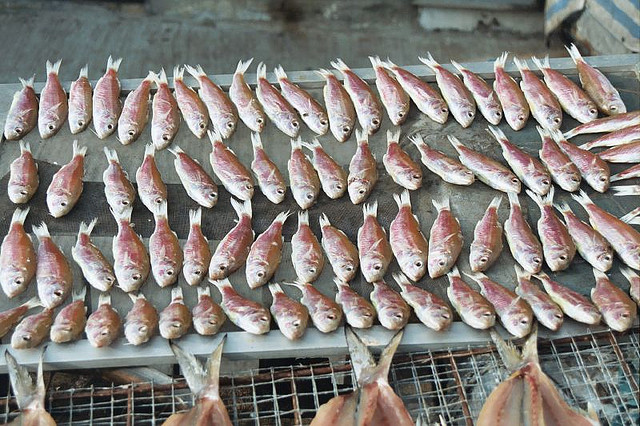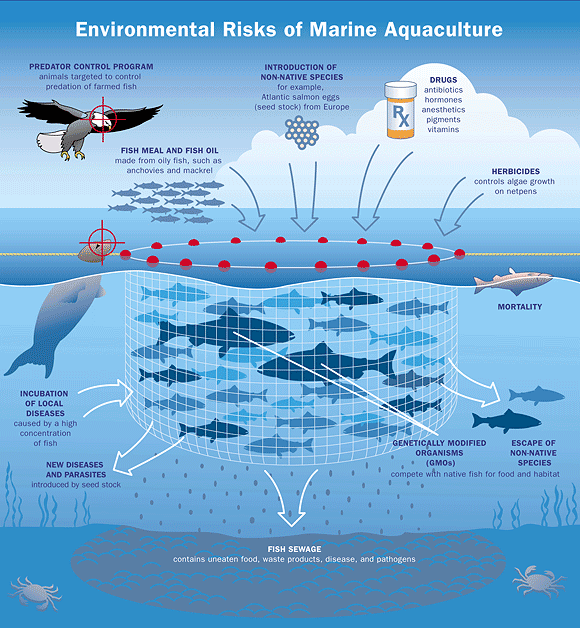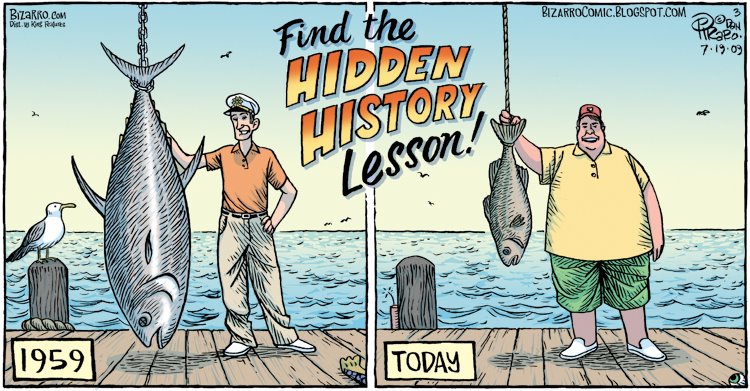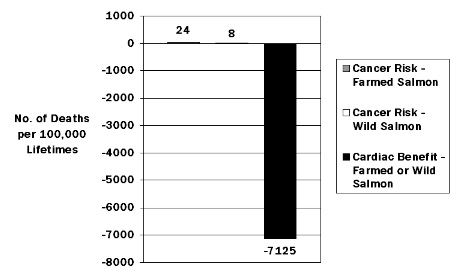Humans have used fish as a food source since our hominid ancestors figured out their opposable thumbs.
Some speculate that if it weren’t for seafood, we wouldn’t even be human, since our brains began to increase in size when we incorporated seafood and other meats into our diet. Without fish (or discovering a big crop of flax) – we might still be apes swinging around in trees.
It’s not surprising that we turned to fish as a food source. After all, the sea contains far more species than land areas.
In fact, an estimated 50-80% of all life on earth is found under the ocean surface — at least we think so, because we’ve barely explored 10% of it.
FishBase currently contains over 30,000 species of fish, and numbers are growing. However, out of those 30-thousand-plus, we consume about 40 species.
Throughout history, the most popular fish for eating include salmon, trout, perch, pike, eels and burbot. (Not to be confused with turbot.)
Why are fish so important?
Fish production and processing
Fishing is now a $71 billion/year industry that employs 200 million people. By 2010 world aquaculture output is expected to surpass beef production.
However, the life of a fisher is a difficult one. There are fewer jobs in the fishing industry today and the price of fishing vessels is more expensive. The occupation is dangerous, and depends on the whims of the water and weather. In the US, the average fisher makes $27,950 USD per year. (More on fishing as an occupation.)
After fish are caught they’re sorted, graded, chilled and usually gutted – then preserved and transported.
Fish flesh has 1 ½ times the water content of other meat, allowing it to turn rancid faster. Removing the water acts as a preservative. Drying fish in open air or the sun is the oldest technique used, but people also salt and smoke fish.

Fish consumption
Worldwide, fish consumption has doubled in the last 30 years. In part, this reflects greater availability, but many fish eaters consume it for the purported health benefits. (More on that below.)
Fish account for between 14% and 17% of the animal protein intake for the world’s human population. The Japanese eat more fish than anyone else in the world, about 40 kg per year.
Fish and fatty acids
Fish tend to be rich in two groups of fatty acids known as docosahexaenoic acid (DHA) and eicosapentaenoic acid (EPA).
These fats are not abundant in the standard North American diet. DHA and EPA, along with alpha-linolenic acid (ALA), found in things like flax, fall under the subheading of omega-3 fats.
EPA and DHA, often cited as being the beneficial components of fish, actually originate in algae, which are the base of the food chain for fish. Fish consume algae and concentrate the EPA and DHA.
What you should know about fish
Aquaculture
Aquaculture, or fish farming, is the breeding of marine species in a closed environment.
In 1970, aquaculture provided 0.7 kg of fish per person per year; by 2002 it had jumped to 6.4 kg.
68% of seafood eaten in North America is ordered at restaurants. 43% of fish eaten in the world are farmed. Consumer Reports found that 56% of salmon labeled as “wild caught” were actually farmed.
Like chicken nuggets or bacon from a factory farmed pig, farmed fish are often exposed to chemicals and mistreatment during each step of the process.
Step 1 – Hatchery
Females are killed, cut open, and the eggs are squeezed out to be mixed with milt (fish sperm). The eggs are soaked in iodine to disinfect and then washed with formalin to kill fungus (formalin is a known carcinogen).
Step 2 – Artificial light
The fish are transferred to new pens and fattened until they reach market size. Artificial light is used to mimic summer, when most fish eat more. Underwater nets are treated with chemicals to prevent the growth of mussels, seaweed and algae.
Step 3 – Fattening
Salmon take about 2.5 years before they reach 12 pounds, then it’s market time. The fish are killed with a pneumatic stunner or dropped into a tank with carbon dioxide. Gills are cut, they bleed out, and machines get rid of spines/fins. This leaves fillets for market.

Salmon yield 300,000 kg of flesh per hectare, which in economic terms is 15 times better than the yield of beef cattle. Further, over the course of a year, aquaponics (symbiotic cultivation of plants and animals) will produce edible flesh yields well beyond 50 times that of beef cattle.
The largest salmon farms hold about 1.3 million fish, nearly 22 pounds per cubic yard. That’s tight, even tighter than battery cages on factory farms. This results in overpopulation, excessive waste, germs, disease and reliance on medications.
Wild salmon get their pink color by eating krill, which provides a carotenoid pigment called astaxanthin. Farmed salmon get a synthetic version of the pigment added to their diets. Translation: self-tanning pills.
Lots of fish means lots of feed.
Salmon are carnivorous and industrial aquaculture has begun to incorporate land animal by products into fish feed, including poultry meal (e.g., intestines, eggs, blood, etc.), feather meal and manure. Some fats in the fish feed now come from GM vegetable oils, which can decrease the omega-3 content of fish.
About 1/3 of the world’s total fish catch goes toward fish meal/oil for farmed fish and other animals.
Many open ocean fish like anchovies, herring and mackerel are caught mainly for this purpose. The indirect use of open ocean fish to feed other animals is inefficient; it’s estimated that 3.9 pounds of wild fish are used to make 1 pound of farmed fish. In addition, 86% of the seafood in America is imported, which means lots of fossil fuels. Bringing a single 10 pound farmed salmon to the consumer is estimated to use 6.2 gallons of diesel fuel.
Thus, globally, fish feedlots represent a net loss in energy. Humans would be better off consuming the other fish directly.
Global currents
Speaking of global, it’s important to understand that fish production and processing is a globalized industry. What’s on your plate may have come from the lake nearby, or it may have come from the other side of the world.
What happens in environments and markets elsewhere can affect your dinner.
For example:
- Competition for fish meal/oil can drive up the price of fish, which pushes this food source out of reach for many of the world’s poorest.
- The American shrimp industry collapsed in 1999 due to cheaper imports. Now, 90% of shrimp in the U.S. are imported. Shrimp used to be a delicacy, but since 2001 Americans eat more shrimp than tuna, up to 4.4 pounds per person per year. They’re able to do this in part thanks to cheap(ened) production elsewhere.
Fish and the environment

The impact of humans upon the environment is also a global concern.
Per capita supply of wild fish for human consumption has been unable to keep pace with the growing population. Fishing and farming practices have already damaged the organic matter necessary to nourish marine life. Consumer demand ensures that the fishing industry continually taps into rapidly declining populations.
In fact, 75% of commercial fish stocks are overused, collapsed, or in a state of repair. We’re down to the last 10% of bluefin tuna and Atlantic cod.
As a result, marine scientists expect a complete collapse of world fish populations by 2048. And no, I don’t think we’ll have access to a Flux Capacitor on January 1st, 2048. We might want to plan ahead.
VIDEO: The End of The Line – Collapsed State
Have you heard of the “Great Pacific Garbage Patch?” You have now. And yes – fish eat this stuff.
We’ve covered environmental eating in depth; see the following:
All About Environmental Eating, Part 1
All About Environmental Eating, Part 2
Fish and health
Eating fish seems to be healthy and decrease chances of disease.
Fats from both wild and farmed fish encourage health promoting effects. Other compounds, including taurine, arginine or vitamin D from the fish, might also be bene-fishal. (Sorry.)
What effects do the fish oils have?
- Cell membranes remain sensitive to hormones.
- Genes that use fatty acids for energy are turned on and genes that promote fat storage are turned off.
- Low grade inflammation can be prevented, which can promote health and alleviate pain.
- Healthy brain tissue and neurotransmitters stabilize, leading to improved mood and focus.
- Cholesterol and triglyceride levels are moderated.
- Blood vessels remain elastic, leading to controlled blood pressure.
- Steroids and stress hormones released from the adrenal glands are balanced.
Eating about 2 servings per week (e.g., 8 ounces total) of fatty fish is enough to get the minimum amount of health promoting fatty acids.
Take note of how fish is prepared, since eating too much smoked fish (and other smoked meats) is known to be one factor in causing stomach cancers.
Fish and toxins
Eating fish is the major source of mercury exposure for humans.
Mercury enters the ocean as a by-product of waste and coal combustion. It’s then converted to methyl mercury by microorganisms and consumed by marine life.
Fish concentrate methyl mercury, but not in fat. In fish, methyl mercury is bound to cysteine, making it less toxic than pure methyl mercury. Still, methyl mercury is readily absorbed in our GI tract (unlike inorganic mercury).
Predatory fish like shark, tuna, king mackerel, tilefish, swordfish and orange roughy concentrate the highest levels of methyl mercury. Fish/seafood that aren’t predatory, including sardines, salmon, clams, and shrimp, have lower levels. Farmed fish generally have the lowest methyl mercury content.
Data indicate that we should limit fish consumption due to the risk of mercury poisoning. Indeed, consuming two meals of predatory fish within 24 hours can more than double the amount of mercury in our bloodstream!
Mercury levels in toenails and hair offer the best biomarkers of chronic mercury exposure. A toxic level of mercury in hair is estimated at 50 ppm. Exposure to mercury causes paresthesias, ataxia and sensory symptoms. These are often reversible when mercury exposure is reduced.
Other potentially harmful compounds in fish include dioxins and polychlorinated biphenyls (PCBs), both carcinogens. The lower priced, farmed seafood (found in many fast-food restaurants) usually contain antibiotics and neurotoxicants.
Farmed fish generally contain higher levels of dioxins and PCBs than wild-caught. Still, we get many PCBs and dioxins from non-seafood sources like meats, dairy products and even some vegetables.
Currently, it appears that the health benefits of eating fish outweigh the potential health problems.

Fish and spirituality
Fish became a major food in the Middle Ages since fasting (no meat) was ordained by the church 166 days each year, including Lent. Meat was regarded as “red and rich,” while fish was regarded as “white, lean, and pure.” Fish symbolized regeneration during fasts and periods of purification.
Some say the decision to eat fish on Friday was based on the early Catholic Church’s ties to the fishing industry.
Sea animals are often classified separately from land animals in religious texts. Jewish dietary laws consider fish to be acceptable, but not shellfish.
Summary and recommendations
In our modern world of poorly labeled, unsustainably harvested, and potentially contaminated seafood, what should we do?
It’s your call.
If you choose to eat seafood, get informed and eat sensibly.
- If it’s not labeled “wild,” it’s farmed.
- The country of origin labeling has little to do with the actual ocean it was caught in.
- Cheap seafood is suspect seafood.
From a toxicity standpoint
Consuming no more than 1 fish meal per week from predatory fish (shark, tuna, swordfish) and no more than 2 per week from non-predatory fish (sardines, salmon, shrimp) is recommended.
For pregnant women (or women trying to become pregnant), nursing mothers, and young children, consuming zero predatory fish meals and no more than 2 fish meals per week from non-predatory fish is recommended. These suggestions don’t guarantee safety. They’re based on the belief of long-term safety for children when exposure levels are maintained within acceptable reference limits – an idea that remains unproven scientifically. Pregnant women should not consume farmed fish more than once per month.
More recommendations on fish consumption related to pregnancy here:
Fish consumption and pregnancy
From a health standpoint
Consuming 1-2 servings of fatty fish per week, from non-predatory sources is likely the best option. For those who want to eliminate contaminants from fish, but want the health benefits, fish oil or algae oil supplements are available, contaminant free. This would be an option for pregnant women (or women trying to become pregnant), nursing mothers, and young children. Farmed fish should not be consumed more than once per month.
Here’s a summary:
Avoid these fish
- Bluefin tuna
- Atlantic cod
- Atlantic halibut
- Chilean sea bass
- Grouper
- Monkfish
- Orange roughy
- Shark
- Skate
- Atlantic sole
- Tilefish
For these fish, know where you are getting them
- Abalone
- Anchovy
- Catfish
- Clams
- Pacific cod
- Pacific halibut
- Crab
- Haddock
- Herring
- Jellyfish
- Lobster
- Mackerel
- Mahi-mahi
- Marlin
- Mullet
- Octopus
- Oysters
- Polluck
- Rockfish
- Sablefish
- Salmon
- Sardines
- Scallops
- Shrimp
- Snapper
- Squid
- Striped bass
- Swordfish
- Tilapia (this is one of the most sustainable varieties of farmed fish)
- Trout
- Tuna
- Whiting
Eat, move, and live… better.©
Yep, we know… the health and fitness world can sometimes be a confusing place. But it doesn’t have to be.
Let us help you make sense of it all with this free special report.
In it you’ll learn the best eating, exercise, and lifestyle strategies — unique and personal — for you.
Click here to download the special report, for free.
References
Click here to view the information sources referenced in this article.




Share